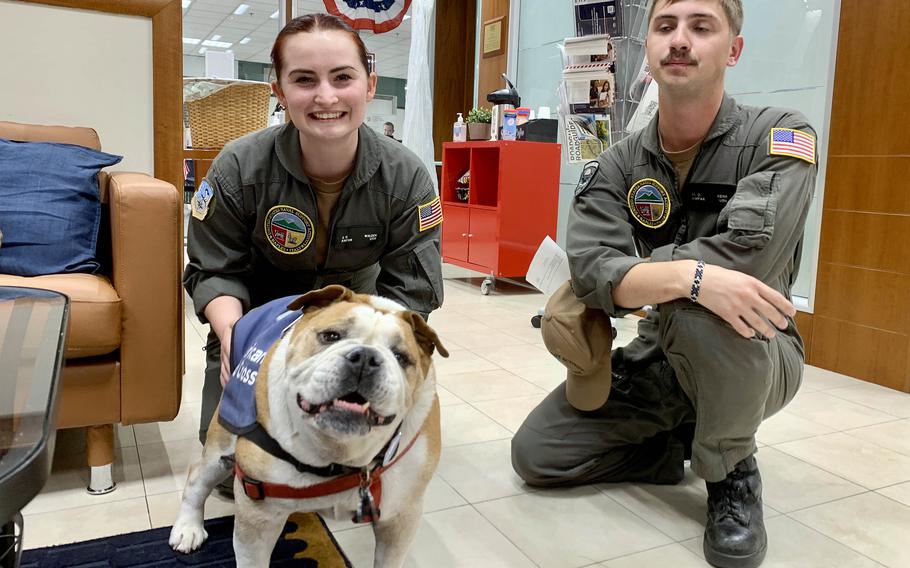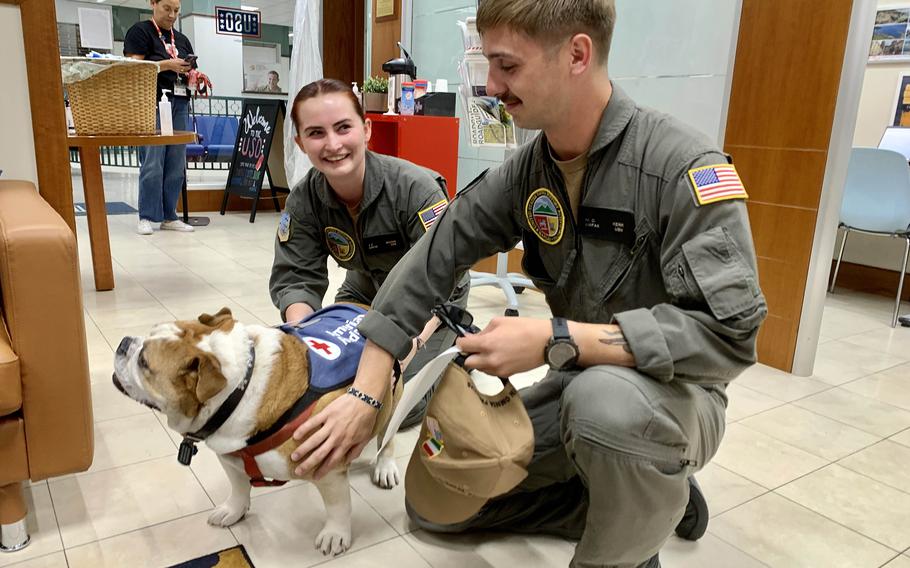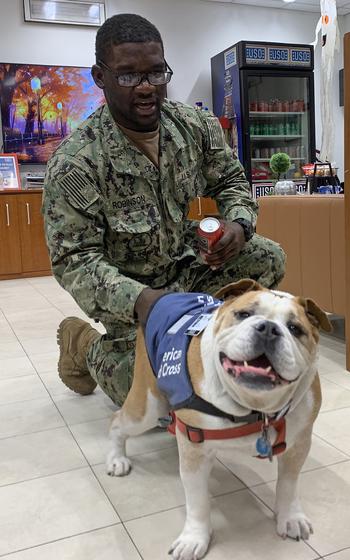
Petty Officer 3rd Class Julia Walden, left, and Seaman Mckade Kerr pet Bentley, a therapy dog who visits the USO center at Naval Support Activity Naples in Italy on Thursdays as part of the organization's canine therapy program. Their visit came on Sept. 28, 2023. (Alison Bath/Stars and Stripes)
NAPLES, Italy — Once nearly as common in the Navy as sailors, dogs are poised to make a comeback as the service strives to broaden its approach to mental health.
Oliver, a golden retriever, and Morgan, a mixed breed, are among several dogs that now regularly staff USO centers overseas as part of the organization’s canine therapy program, the Navy announced in July.
The two dogs made their debut earlier in the summer at Naval Air Station Sigonella on the Italian island of Sicily.
Six American Red Cross-certified therapy dogs joined the center at Naval Support Activity Naples in September as part of the same program, implementation of which will vary by base.

Petty Officer 3rd Class Julia Walden, left, and Seaman Mckade Kerr pet therapy dog Bentley on Sept. 28, 2023, at the USO center at Naval Support Activity Naples in Italy. Kerr said spending time with Bentley was fun but also made him miss his two golden retrievers in the U.S. (Alison Bath/Stars and Stripes)
There are plans to expand to other locations, such as Naval Station Rota in Spain, USO officials said in September.
They join Sage, a yellow Labrador retriever who deployed on the USS Gerald R. Ford in April as part of a pilot program, according to the Navy. The carrier has been on patrol in the U.S. Naval Forces Europe-Africa/U.S. 6th Fleet area of operations.
“Deploying support dogs such as Sage on ships is another measure the Navy is testing out in its efforts to provide a holistic and well-rounded selection of mental health resources for sailors,” a Navy spokesperson said in September.
Sage is the only support dog deployed on a Navy ship, but more could be on the way pending evaluation of the program, the spokesperson said. Chaplains, psychologists and counselors also are on board to help sailors, the spokesperson added.
The Navy has been grappling with an increase in sailor suicides since 2006, according to data on its website.
In 2022, 70 active-duty sailors died by suicide, a rate of 20.1 per 100,000, preliminary data show. By way of comparison, 32 active-duty sailors killed themselves in 2006, putting the rate of Navy suicides at 9.1 per 100,000 the lowest in the last 17 years, according to the data.

Seaman Gude Robinson and Bentley, a 10-year-old English bulldog, share each other’s company Sept. 28, 2023, at the USO center at Naval Support Activity Naples in Italy. The center recently debuted six therapy dogs as a way to improve sailors’ mental well-being. (Alison Bath/Stars and Stripes)
Since then, the rate mostly has climbed, reaching 22.1 in 2019, when 74 active-duty sailors died by suicide, according to the data.
As of August, suicide has claimed the lives of 41 active-duty sailors this year, according to the Navy.
The rise in suicides is not limited to the Navy, however.
From Jan. 1 to March 31, 94 active-duty service members across the armed forces killed themselves, according to a Defense Department report released in July. That is up 25% from the same period in 2022, according to the report.
The Army had the highest increase, with 12 more suicides in the first three months of this year compared with the same time last year, the report stated. The Navy’s number stayed the same.
At NSA Naples’ Capodichino site Thursday, a steady stream of sailors stepped into the USO to visit with Bentley, a 10-year-old English bulldog who goes by the nickname Gordo.
Most appeared to come in solely to visit with the dog, picking up a snack or drink while they were there.
“(Dogs) make you feel like you’re not alone,” said Petty Officer 3rd Class Julia Walden, who left her dog back in the U.S. but acquired two while living in Italy. “They give you something to look forward to.”
Petting or playing with a dog relieves stress, eases homesickness or distracts people from problems, said Margaret McCullough, the USO Sigonella center manager.
She told the story of a female sailor who recently spent time with the dogs in Sigonella and broke down in tears. The emotion surprised the sailor, who said she’d been going through some personal issues, McCullough said.
The power of animals for therapy is “undeniable when you see those reactions,” said McCullough, who is Morgan’s owner.
As it turns out, dogs have a long history of providing that type of comfort, companionship and sense of normalcy to sailors, said Gordon Calhoun, a historian and curator with the National Museum of the U.S. Navy.
For much of the service’s history, canines were brought aboard ship by sailors, who also took their cats, goats and other farm animals along for yearslong voyages, Calhoun said.
More exotic creatures such as bears, wallabies and jaguars also were known to be aboard, Calhoun said.
By World War II, most animals on ships were dogs or cats, but that changed when the Navy turned its attention to pride and professionalism initiatives, he said.
“Attitudes changed about it and you saw less and less of them coming into today,” Calhoun said.
Dogs typically aren’t allowed on ships except during in-port visits from organizations such as Mutts with a Mission, the Navy spokesperson said.
Dogs chosen to be therapy canines must meet a variety of criteria, including comfort level in social situations, USO officials said.
The connection between sailors and animals endures, which speaks to the more human side of naval history, Calhoun said.
It offers a reminder that sailors are humans operating these ships, keeping us safe, he said.